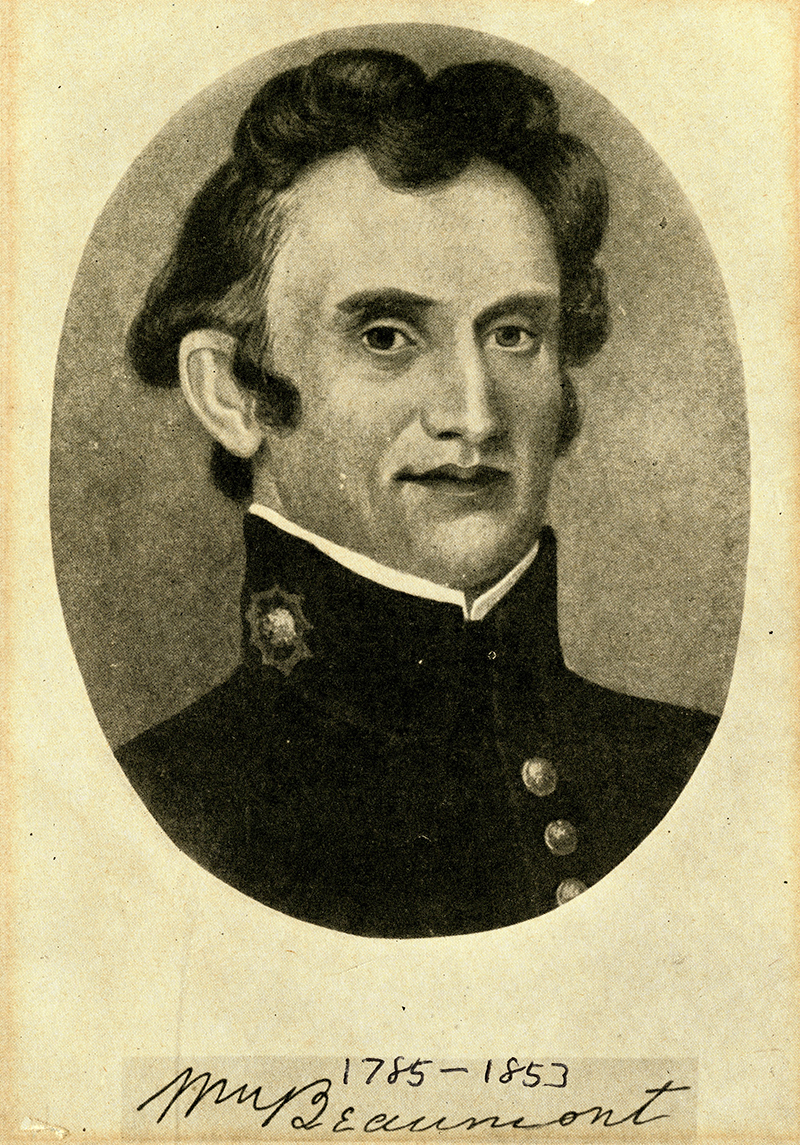Experiments and observations on the gastric juice, and the physiology of digestion. Plattsburgh: F.P. Allen, 1833.
“Experiments on the process of digestion, in a boy with a fistulous opening into his stomach.” [In] Philadelphia journal of the medical and physical sciences, v. 13. Philadelphia: H. C. Carey & Lea, 1826. pp. 382-384.
“Further experiments on the case of Alexis San Martin.” [In] Medical recorder, v. 9. Philadelphia: James Webster, 1826. pp. 94-97.
 William Beaumont of Connecticut received his medical license from the Third Medical Society of Vermont in 1812. He became a United States army surgeon during the War of 1812. Later, while stationed in Michigan in 1822, he began treating Alexis St. Martin, whose gunshot wound in the abdomen left an opening in the stomach, or a gastric fistula. Beaumont took the helpless patient into his home, feeding and doctoring him for two years. Despite efforts to close the fistula, it remained opened (Kelly & Burrage 83). In 1825, after the patient had recovered somewhat, Beaumont began performing experiments on him, making valuable observations about the workings of the digestive system, a physiological subject that scientists previously understood very little.
William Beaumont of Connecticut received his medical license from the Third Medical Society of Vermont in 1812. He became a United States army surgeon during the War of 1812. Later, while stationed in Michigan in 1822, he began treating Alexis St. Martin, whose gunshot wound in the abdomen left an opening in the stomach, or a gastric fistula. Beaumont took the helpless patient into his home, feeding and doctoring him for two years. Despite efforts to close the fistula, it remained opened (Kelly & Burrage 83). In 1825, after the patient had recovered somewhat, Beaumont began performing experiments on him, making valuable observations about the workings of the digestive system, a physiological subject that scientists previously understood very little.
Beaumont was well versed in existing literature on digestive physiology, and he used this knowledge in designing his experiments. One of his methods was to tie a string around a piece of food, insert it into the stomach through the fistula, and then remove it after varying periods of time to see the progress of digestion (Duffin 56). Through experimentation, he determined the speed and ease of digestion for different types of food, as well as stomach temperature and movements during digestion (One Hund. Books 61). Beaumont conducted his experiments in a professional and careful manner, and when presented with questions out of his realm of specialty, he consulted authorities in other scientific fields. He sent samples of gastric juice to well-known chemists for testing, and they discovered its composition (Dict. Sci. Bio., Vol. 1&2, p. 542). His preliminary papers appeared in the Philadelphia journal of the medical and physical sciences and the Medical recorder, and their importance was recognized in both America and Europe. The Reynolds-Finley Library has some of these journal entries as well as a first edition of Experiments and observations on the gastric juice, and the physiology of digestion, in which Beaumont reveals results from about 240 experiments on St. Martin. Dedicated to his research, Beaumont struggled for years to keep St. Martin willing and in close enough proximity to continue his studies. After the book’s publication in 1833, St. Martin no longer allowed the experiments, and so Beaumont discontinued his study of gastric processes. However, he holds an important place in the history of medicine as the first to accurately describe the digestive system, and the first American to make a significant contribution to the field of physiology (One Hund. Books 61).
Dict. Sci. Bio., Vol. 1&2, pp. 542-544; Duffin, Hist. of Med., p. 56; Kelly & Burrage, Dict. Amer. Med. Bio., pp. 82-84; One Hund. Books, 61; Reynolds Historical Library, Rare books and coll…, 351, 354, 355.
Image: William Beaumont, Print Collection, Reynolds-Finley Historical Library.
